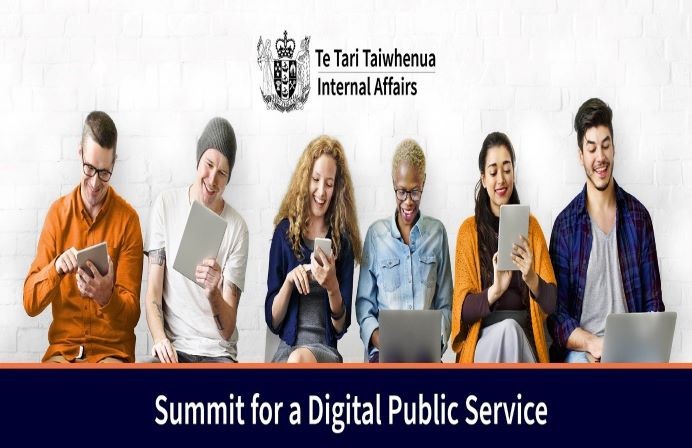
In his opening keynote, David Clark, New Zealand’s Minister for the Digital Economy and Communications, challenged the attendees at the 2022 Summit for a Digital Public Service.
“We need to be ambitious and leverage the opportunity that digital technology can bring for the tech sector, for our wider business community, and the well-being of all New Zealanders,” he said, as he introduced the recently released Digital Strategy for Aotearoa.
The Summit for a Digital Public Service was held both in-person and virtually on 6 October 2022 and attended by more than 300 delegates responsible for driving digital transformation across the New Zealand public sector.
The Summit comprised showcases, presentations and panel discussions. These highlighted the considerations and successes in digital delivery in the New Zealand Public Service as it continues to build a robust and agile digital government.
Minister Clark highlighted the release of the Digital Strategy for Aotearoa in delivering the opening keynote. Released on 14 September 2022, the Strategy’s vision is that New Zealand’s people, economy and environment flourish in the digital era. It provides a framework built on three pillars: Mahi Tika, Mahi Tahi and Mahi Ake, or trust, inclusion, and growth, respectively.
Under this Strategy, a work program has been established. Initiatives include:
- Digital Identity Services Trust Framework – setting out rules for the delivery of digital identity services, addressing gaps in current regulation and assisting the development of trusted, people-centred digital identity services
- Christchurch Call – a pledge to eliminate Terrorist and Violent Extremist Content online while preserving human rights and a free, open and secure internet
- Digital Boost – offering training and support to small businesses to help them improve their digital skills to reach 90,000 firms
- Digital Technologies Industry Transformation Plan – helping to accelerate economic recovery from COVID-19 and will move New Zealand towards the goal of a high-wage, low-emissions economy
With several strategies already underway, it can become confusing for those driving delivery. In describing the relationship between the various strategies., Minister Clark explained that the Strategy for a Digital Public Service, the New Zealand Data Strategy and Roadmap and the Cyber Security Strategy sits beneath the Digital Strategy for Aotearoa. These form the enablers for a modern and adaptive public Service.
Paul James, Government’s Chief Digital Officer (GCDO), spoke of the reality of the New Zealand public service as not being a highly centralised service.
“Most transformation programs won’t be led and delivered by the GCDO. So achieving the full benefits of digital government for customers and communities will require us (agencies) to act as a unified public service,” he explained.
James described the role of system leadership to put the structures, guidance and enablers to create an integrated and agile Public Service. He highlighted two key projects, the Cloud adoption program and the Mana Ōrite Agreement.
Under the Cloud adoption program, several activities have supported agencies’ consumption of cloud-based services. In addition, initiatives have successfully encouraged and supported hyper-scale cloud providers to invest in New Zealand. As a result, over the program’s life, NZ has seen an estimated $10 billion-plus in investment and more than 10 new hyper-scale data centres being built or upgraded, some involving global names like Microsoft and Amazon.
The program has also established the Cloud capability network, a mechanism to support collaboration and learning, supporting agencies in their cloud adoption journeys.
Critical to Cloud adoption is respecting the rights of Maori established under Te Tiriti o Waitangi (the treaty of Waitangi) and respecting data as Taonga (treasure). The Mana Ōrite Agreement is a partnership agreement between the Department of Internal Affairs and Maori via the Data and Digital Iwi leaders Group (DILG). A similar agreement has been in place between Stats NZ and the DILG for some time.
Through these agreements, Initiatives are following a co-design process providing government agencies with an approach to establishing governance, policies and frameworks supporting data governance and cloud adoption. The method enables Māori data needs, interests and aspirations and ensures future developments are informed by and with Māori.
One such initiative, led by Stats NZ, aims to establish data governance policies and frameworks that shape how NZ can unlock the potential of data. This is to help solve economic and societal challenges, as well as how agencies address risks associated with the use of data.
The Māori Data Governance initiative aims to develop and implement guidance about a data governance approach that reflects iwi and Māori interests and embeds Te Tiriti.
Similarly, the Cloud program, led by the GCDO, aims to establish guidance and frameworks to support agency adoption of the cloud. The co-designed direction will inform how agencies can adopt cloud services while respecting data sovereignty.
GCDO also announced it is in the final stages of reviewing and updating the Strategy for a Digital Public Service action plan. The Digital Public Service branch has consulted with stakeholders and is finalising a draft for consideration.
The NZ Government will also review its Cloud First policy, which requires public sector organisations to accelerate their adoption of cloud services in a balanced way. However, there was no indication of when that review would occur.





